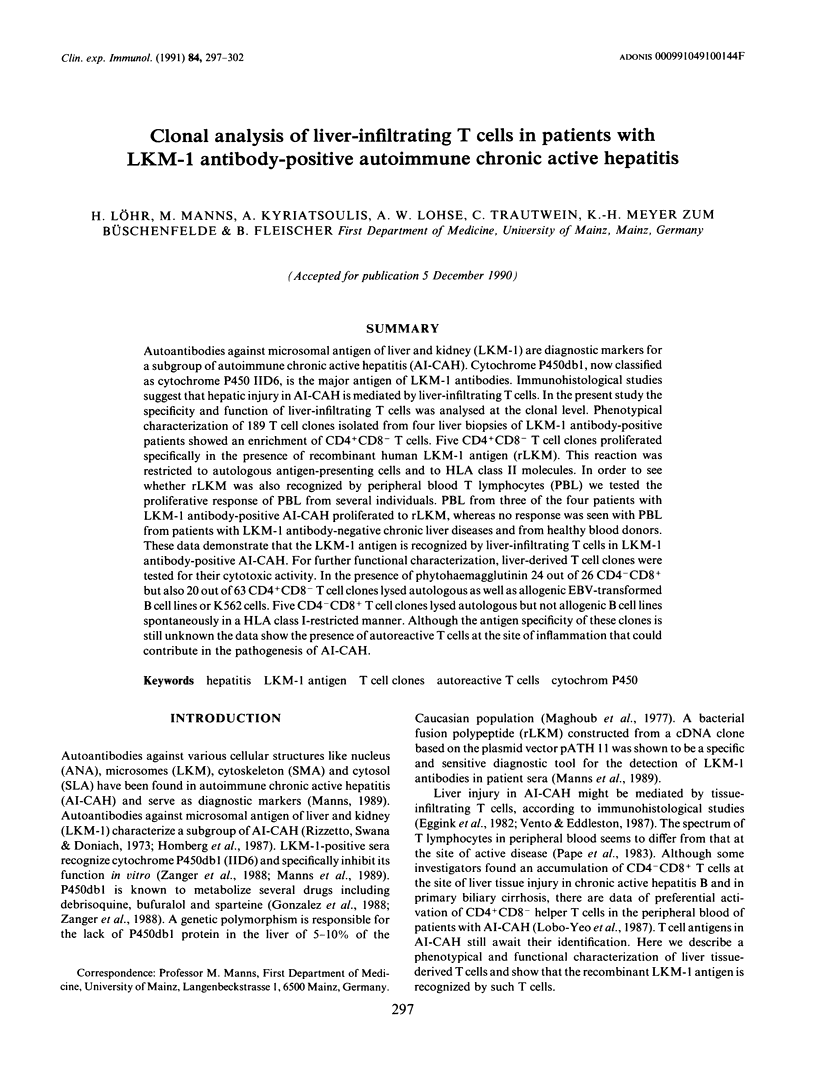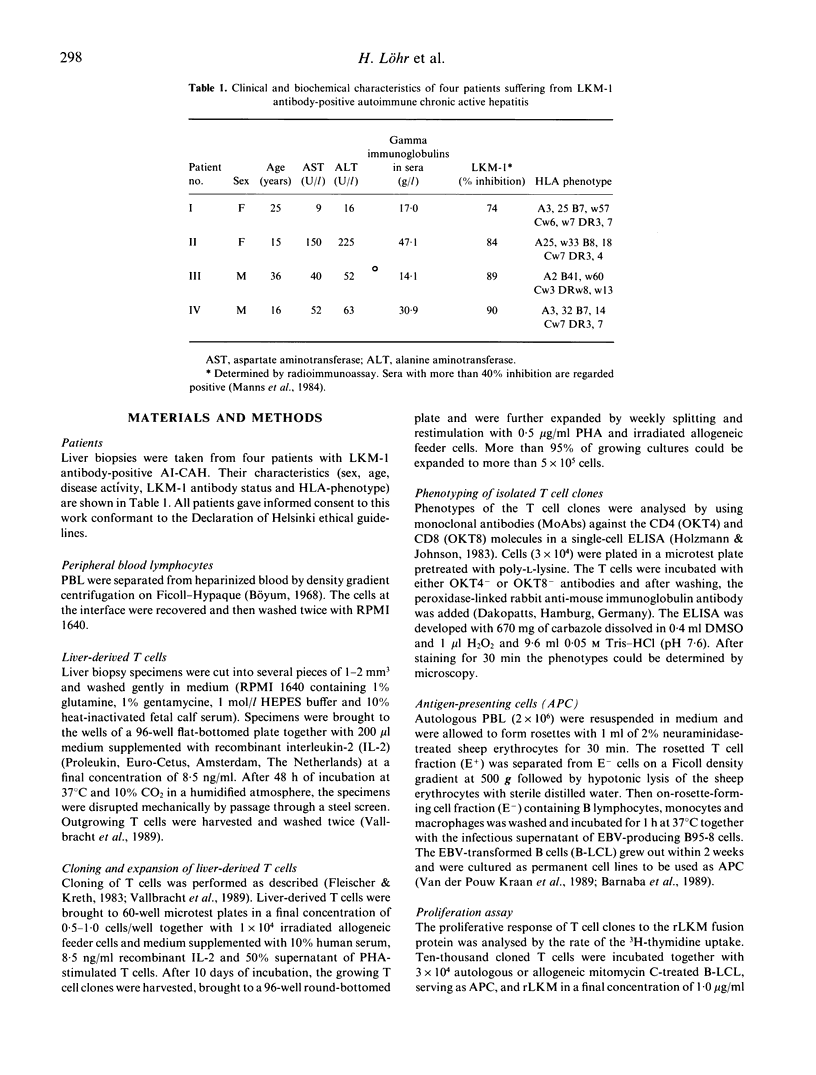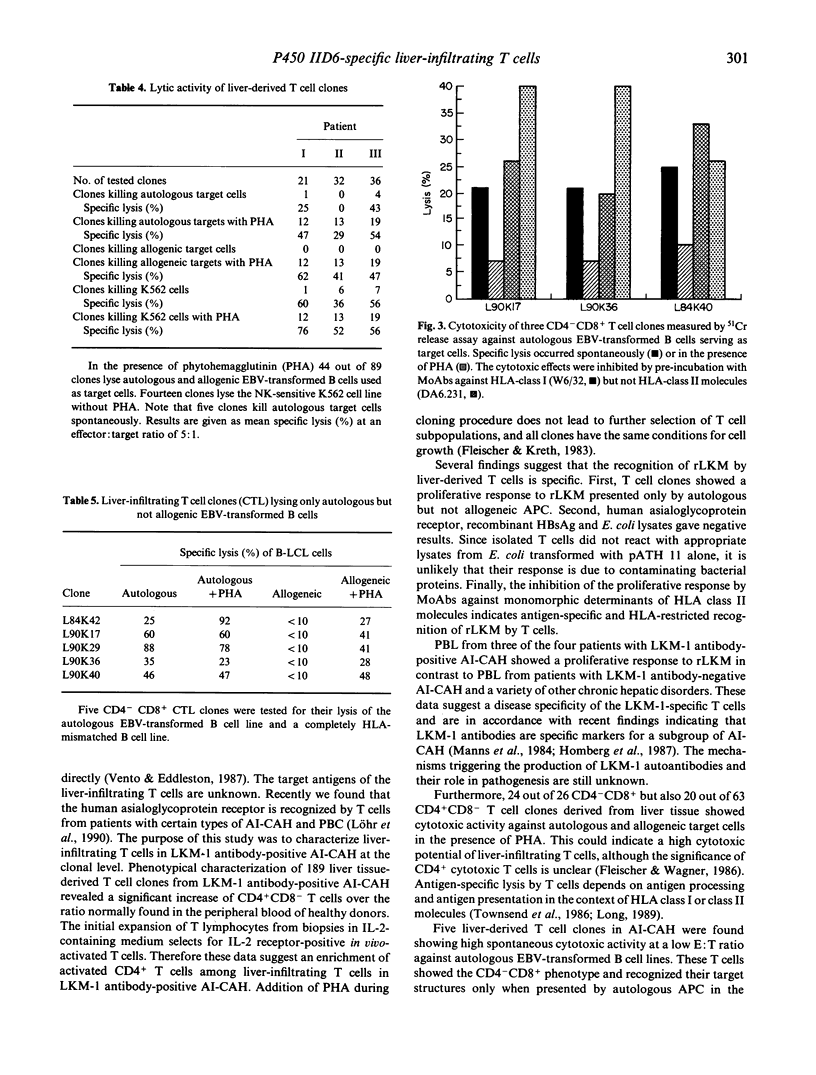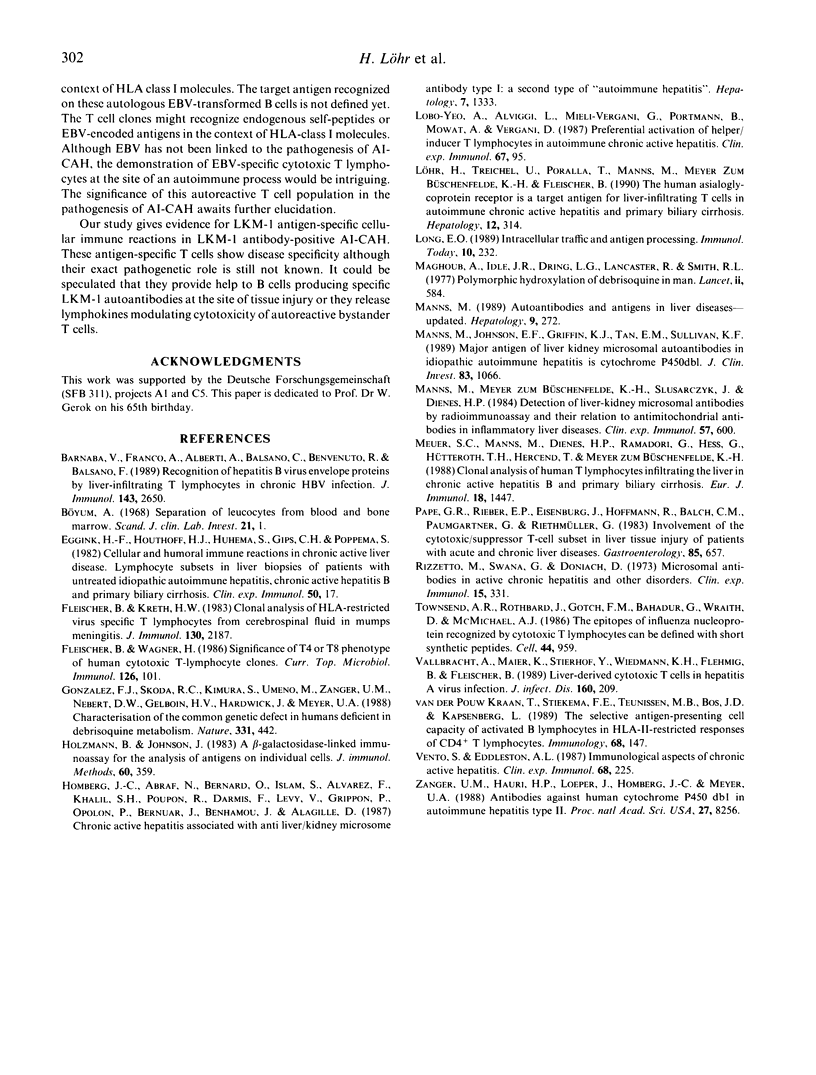Abstract
Autoantibodies against microsomal antigen of liver and kidney (LKM-1) are diagnostic markers for a subgroup of autoimmune chronic active hepatitis (AI-CAH). Cytochrome P450dbl, now classified as cytochrome P450 IID6, is the major antigen of LKM-1 antibodies. Immunohistological studies suggest that hepatic injury in AI-CAH is mediated by liver-infiltrating T cells. In the present study the specificity and function of liver-infiltrating T cells was analysed at the clonal level. Phenotypical characterization of 189 T cell clones isolated from four liver biopsies of LKM-1 antibody-positive patients showed an enrichment of CD4+ CD8- T cell clones proliferated specifically in the presence of recombinant human LKM-1 antigen (rLKM). This reaction was restricted to autologous antigen-presenting cells and to HLA class II molecules. In order to see whether rLKM was also recognized by peripheral blood T lymphocytes (PBL) we tested the proliferative response of PBL from several individuals. PBL from three of the four patients with LKM-1 antibody-positive AI-CAH proliferated to rLKM, whereas no response was seen with PBL from patients with LKM-1 antibody-negative chronic liver diseases and from healthy blood donors. These data demonstrate that the LKM-1 antigen is recognized by liver-infiltrating T cells in LKM-1 antibody-positive AI-CAH. For further functional characterization, liver-derived T cell clones were tested for their cytotoxic activity. In the presence of phytohaemagglutinin 24 out of 26 CD4- CD8+ but also 20 out of 63 CD4+ CD8- T cell clones lysed autologous as well as allogenic EBV-transformed B cell lines or K562 cells. Five CD4- CD8+ T cell clones lysed autologous but not allogenic B cell lines spontaneously in a HLA class I-restricted manner. Although the antigen specificity of these clones is still unknown the data show the presence of autoreactive T cells at the site of inflammation that could contribute in the pathogenesis of AI-CAH.
Full text
PDF





Selected References
These references are in PubMed. This may not be the complete list of references from this article.
- Barnaba V., Franco A., Alberti A., Balsano C., Benvenuto R., Balsano F. Recognition of hepatitis B virus envelope proteins by liver-infiltrating T lymphocytes in chronic HBV infection. J Immunol. 1989 Oct 15;143(8):2650–2655. [PubMed] [Google Scholar]
- Fleischer B., Kreth H. W. Clonal analysis of HLA-restricted virus-specific cytotoxic T lymphocytes from cerebrospinal fluid in mumps meningitis. J Immunol. 1983 May;130(5):2187–2190. [PubMed] [Google Scholar]
- Gonzalez F. J., Skoda R. C., Kimura S., Umeno M., Zanger U. M., Nebert D. W., Gelboin H. V., Hardwick J. P., Meyer U. A. Characterization of the common genetic defect in humans deficient in debrisoquine metabolism. Nature. 1988 Feb 4;331(6155):442–446. doi: 10.1038/331442a0. [DOI] [PubMed] [Google Scholar]
- Holzmann B., Johnson J. P. A beta-galactosidase linked immunoassay for the analysis of antigens on individual cells. J Immunol Methods. 1983 Jun 10;60(3):359–367. doi: 10.1016/0022-1759(83)90293-4. [DOI] [PubMed] [Google Scholar]
- Homberg J. C., Abuaf N., Bernard O., Islam S., Alvarez F., Khalil S. H., Poupon R., Darnis F., Lévy V. G., Grippon P. Chronic active hepatitis associated with antiliver/kidney microsome antibody type 1: a second type of "autoimmune" hepatitis. Hepatology. 1987 Nov-Dec;7(6):1333–1339. doi: 10.1002/hep.1840070626. [DOI] [PubMed] [Google Scholar]
- Lenzen R., Funk A., Kolb-Bachofen V., Strohmeyer G. Norepinephrine-induced cholestasis in the isolated perfused rat liver is secondary to its hemodynamic effects. Hepatology. 1990 Aug;12(2):314–321. doi: 10.1002/hep.1840120220. [DOI] [PubMed] [Google Scholar]
- Lobo-Yeo A., Alviggi L., Mieli-Vergani G., Portmann B., Mowat A. P., Vergani D. Preferential activation of helper/inducer T lymphocytes in autoimmune chronic active hepatitis. Clin Exp Immunol. 1987 Jan;67(1):95–104. [PMC free article] [PubMed] [Google Scholar]
- Mahgoub A., Idle J. R., Dring L. G., Lancaster R., Smith R. L. Polymorphic hydroxylation of Debrisoquine in man. Lancet. 1977 Sep 17;2(8038):584–586. doi: 10.1016/s0140-6736(77)91430-1. [DOI] [PubMed] [Google Scholar]
- Manns M. P., Johnson E. F., Griffin K. J., Tan E. M., Sullivan K. F. Major antigen of liver kidney microsomal autoantibodies in idiopathic autoimmune hepatitis is cytochrome P450db1. J Clin Invest. 1989 Mar;83(3):1066–1072. doi: 10.1172/JCI113949. [DOI] [PMC free article] [PubMed] [Google Scholar]
- Manns M. Autoantibodies and antigens in liver diseases--updated. J Hepatol. 1989 Sep;9(2):272–280. doi: 10.1016/0168-8278(89)90063-9. [DOI] [PubMed] [Google Scholar]
- Manns M., Meyer zum Büschenfelde K. H., Slusarczyk J., Dienes H. P. Detection of liver-kidney microsomal autoantibodies by radioimmunoassay and their relation to anti-mitochondrial antibodies in inflammatory liver diseases. Clin Exp Immunol. 1984 Sep;57(3):600–608. [PMC free article] [PubMed] [Google Scholar]
- Pape G. R., Rieber E. P., Eisenburg J., Hoffmann R., Balch C. M., Paumgartner G., Riethmüller G. Involvement of the cytotoxic/suppressor T-cell subset in liver tissue injury of patients with acute and chronic liver diseases. Gastroenterology. 1983 Sep;85(3):657–662. [PubMed] [Google Scholar]
- Rizzetto M., Swana G., Doniach D. Microsomal antibodies in active chronic hepatitis and other disorders. Clin Exp Immunol. 1973 Nov;15(3):331–344. [PMC free article] [PubMed] [Google Scholar]
- Townsend A. R., Rothbard J., Gotch F. M., Bahadur G., Wraith D., McMichael A. J. The epitopes of influenza nucleoprotein recognized by cytotoxic T lymphocytes can be defined with short synthetic peptides. Cell. 1986 Mar 28;44(6):959–968. doi: 10.1016/0092-8674(86)90019-x. [DOI] [PubMed] [Google Scholar]
- Vallbracht A., Maier K., Stierhof Y. D., Wiedmann K. H., Flehmig B., Fleischer B. Liver-derived cytotoxic T cells in hepatitis A virus infection. J Infect Dis. 1989 Aug;160(2):209–217. doi: 10.1093/infdis/160.2.209. [DOI] [PubMed] [Google Scholar]
- Van Der Pouw Kraan T. T., Stiekema F. E., Teunissen M. B., Bos J. D., Kapsenberg L. The selective antigen-presenting cell capacity of activated B lymphocytes in HLA-II-restricted responses of CD4+ T lymphocytes. Immunology. 1989 Oct;68(2):147–153. [PMC free article] [PubMed] [Google Scholar]
- Vento S., Eddleston A. L. Immunological aspects of chronic active hepatitis. Clin Exp Immunol. 1987 May;68(2):225–232. [PMC free article] [PubMed] [Google Scholar]
- Zanger U. M., Hauri H. P., Loeper J., Homberg J. C., Meyer U. A. Antibodies against human cytochrome P-450db1 in autoimmune hepatitis type II. Proc Natl Acad Sci U S A. 1988 Nov;85(21):8256–8260. doi: 10.1073/pnas.85.21.8256. [DOI] [PMC free article] [PubMed] [Google Scholar]


